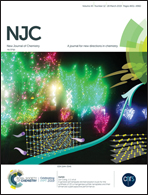Mussel-inspired fabrication of pH-sensitive biomimetic hydrogels based on greenhouse gas carbon dioxide†
Abstract
The greenhouse gas carbon dioxide was converted to an oligomeric poly(propylene carbonate)-diol by a high activity salen–Co(III) catalyst. The new mussel biomimetic hydrogel was synthesized by the reaction of poly(propylene carbonate)-diol with 1,6-hexamethylene diisocyanate followed by lysine dopamine as a chain extender. DSC tests indicate that the hydrogel has two Tg peaks, and they gradually become compatible upon increasing the molecular weight of poly(propylene carbonate)-diol. The TGA curve shows that the hydrogel gradually degrades with the degradation of the dopamine side chain, the poly(propylene carbonate) backbone and the polyurethane backbone. UV-vis spectroscopy showed that when mixed with Fe3+, Fe3+ has different complex numbers with the hydrogel at different pH values, accompanied with color changes. Rheological tests show that the stronger the alkalinity, the greater the elastic modulus of the hydrogel. SEM confirmed the cross-linking structure of the hydrogel. The numerous catechol groups impart good cell affinity and bio-tissue adhesion to the hydrogel and promote tissue adhesion and integration. By using CO2, the biomimetic material can reduce greenhouse gas emissions, which will have broad application prospects.



 Please wait while we load your content...
Please wait while we load your content...